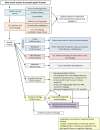Clinical and Instrumental Characterization of Patients With Late-Onset Epilepsy
- PMID: 35359649
- PMCID: PMC8963711
- DOI: 10.3389/fneur.2022.851897
Clinical and Instrumental Characterization of Patients With Late-Onset Epilepsy
Abstract
Epilepsy is classically considered a childhood disease. However, it represents the third most frequent neurological condition in the elderly, following stroke, and dementia. With the progressive aging of the general population, the number of patients with Late-Onset Epilepsy (LOE) is constantly growing, with important economic and social consequences, in particular for the more developed countries where the percentage of elderly people is higher. The most common causes of LOE are structural, mainly secondary to cerebrovascular or infectious diseases, brain tumors, trauma, and metabolic or toxic conditions. Moreover, there is a growing body of evidence linking LOE with neurodegenerative diseases, particularly Alzheimer's disease (AD). However, despite a thorough characterization, the causes of LOE remain unknown in a considerable portion of patients, thus termed as Late-Onset Epilepsy of Unknown origin (LOEU). In order to identify the possible causes of the disease, with an important impact in terms of treatment and prognosis, LOE patients should always undergo an exhaustive phenotypic characterization. In this work, we provide a detailed review of the main clinical and instrumental techniques for the adequate characterization of LOE patients in the clinical practice. This work aims to provide an easy and effective tool that supports routine activity of the clinicians facing LOE.
Keywords: Alzheimer's disease; brain MRI; cerebrospinal fluid; computed tomography; electroencephalography; late-onset epilepsy; neuropsychology; positron emission tomography.
Copyright © 2022 DiFrancesco, Labate, Romoli, Chipi, Salvadori, Galimberti, Perani, Ferrarese and Costa.
Conflict of interest statement
The authors declare that the research was conducted in the absence of any commercial or financial relationships that could be construed as a potential conflict of interest.
Figures
References
Publication types
LinkOut - more resources
Full Text Sources


